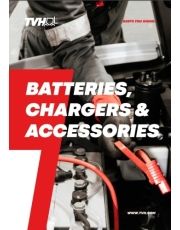How do I correctly charge traction batteries?
Batteries are often referred to as the ‘heart of the electric lift truck’. So it is important to take care of them in the best possible way. But what do you need to pay attention to in order to charge your traction batteries as efficiently as possible? We gathered some tips for you.
When do I need to charge my battery?
It is best to charge your battery immediately after it has been discharged. So never leave your traction batteries stored in an uncharged condition.
Batteries can never be discharged more than 80% of their rated capacity. A deeper discharge leads to wear of the active mass en results in a lower effective capacity.
How long should my battery charge?
There is no univocal reply to that question. The charging time of your battery depends on the charge factor on the one hand, and the type of charger on the other hand.
Charge factor
Charging is battery is done by putting in more energy than what was consumed. The CF (charge factor) of a battery is the ratio between the charged ampere hours and the ampere hours (Ah) that were consumed. Most batteries have a charge factor of 1,2.
E.g.: a traction battery with a rated capacity of 1000 Ah has discharged 80% (800 Ah). At a charge factor (CF) of 1,2, then 1,2 x 800 Ah = 960 Ah must be put back into the battery.
Type of charger
Different types of battery chargers are available on the market. In addition to the conventional or low-frequency charger, another common option is a high-frequency charger. A high-frequency charger is quite a bit more expensive to purchase, but charges batteries faster and cheaper than a conventional charger. Thanks to the intelligent charging technology, batteries last longer. A high-frequency charger charges efficiently and prevents premature wear to both the battery and the charger.
Risks when charging
When charging your traction batteries, there are some risks to take into account.
- Heat: Heat is generated when charging a battery. If too much heat is generated, a fire can start.
- Oxyhydrogen: Charging wet batteries produces hydrogen, generated by the electrolysis of the electrolyte. In combination with the oxygen in the air, the released hydrogen (H2) can form an explosive mixture (oxyhydrogen). Hydrogen is lighter than air and rises to the highest point. That is why sufficient ventilation must always be provided when charging.
- Sparks: When you disconnect a battery from the charger while it is powered, sparks can be generated. These sparks can cause the formed oxyhydrogen to explode.
Prevention measures while charging
 Provide a separate charging area.
Provide a separate charging area.- Remove flammable material in the vicinity of the battery and charger.
- Ventilate the charging area as much as possible. This way you prevent oxyhydrogen from accumulating.
- Prohibit smoking, welding or grinding in the charging zone.
- Provide an explosion-proof electrical installation (lighting, sockets …).
- Prevent short circuits: never place metal objects on the battery.
- Place the charger on a support if possible. This way you prevent dust from accumulating and causing a fire.
- Check the charging cables and have them repaired immediately if you detect any damage.
- Switch off the charger before connecting or disconnecting the battery.
- Only let well-trained personnel perform the actions when charging.
For more info about battery chargers, we gladly refer you to the Energic Plus website.
Annelies, TVH blogger

